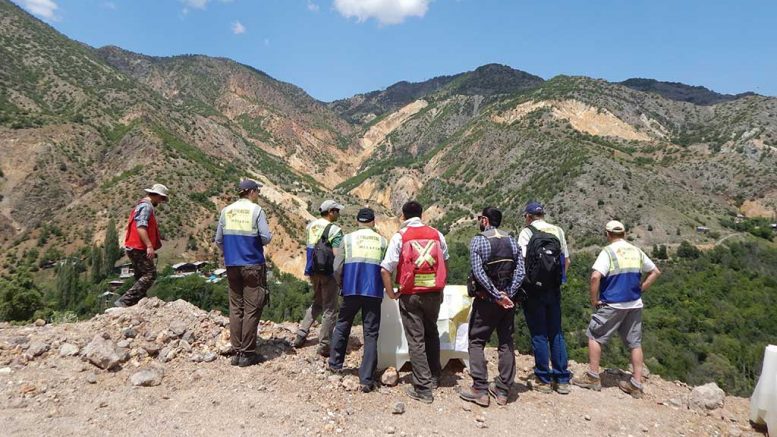Mariana Resources (TSX: MRY; LON-AIM: MARL) has wasted little time since drilling the first two discovery holes in January 2015 at its high-grade Hot Maden copper-gold project in northeastern Turkey.
The junior put out its first resource estimate on the project in August 2015, started work on a preliminary economic assessment (PEA) in June 2016, updated the resource the next month, and has just completed a PEA that outlines the potential for a US$1.4-billion post-tax net present value and a 153% post-tax internal rate of return. It also expects to wrap up a prefeasibility study (PFS) with its partner during this year’s third quarter.
Mariana owns 30% of the joint-venture project, 1,050 km east of Istanbul, and its Turkish partner Lidya owns 70%. Lidya completed its earn-in in January 2016 and is the project operator.
The PEA envisions an underground mine that would produce 2.6 million oz. gold and 142,000 tonnes copper over a nine-year mine life. Total capex — initial and sustaining — is pegged at US$261 million, and would be paid back in just over two years.
Mariana’s chief executive officer Glen Parsons was not available for comment at press time.
The PEA uses an annual throughput base-case mining scenario of 1 million tonnes per year, a US$1,250 per oz. gold price and US$2.75 per lb. copper price. It also factored in a 20% corporate tax rate, a 2.6% state royalty and a 2% net smelter return royalty to Sandstorm Gold (TSX: SSL; NYSE: SAND).
The study outlines operating costs of US$31.05 per tonne, processing operating costs of US$15.13 per tonne, and general and administrative operating costs of US$10.18 per tonne. Gold and copper recoveries are an estimated 88% and 90%.
The mining operation would use a decline, mechanized transverse and longitudinal long-hole stoping with engineered paste fill.
In addition to the technical studies and optimization that the partners will need for a PFS, they have budgeted a 20,000-metre drill program this year, south of the project’s Main zone.
The focus at Hot Maden is exploring for strike extensions to the known mineralization along the 5 km long Hot Maden fault and hydrothermal alteration zone, and testing (through deep geophysics and drilling), the potential for more gold-copper resources beneath the mineralization’s depth limit, which is 400 metres below surface.
The updated resource estimate completed in July 2016 is based on 62 drill holes (17,000 metres) and outlines an indicated resource in the Main zone of 7.1 million tonnes grading 12.2 grams gold per tonne, 2.3% copper and 0.2% zinc (15 grams per equivalent tonne gold), for 2.79 million contained oz. gold and 166,000 tonnes copper (3.43 million equivalent oz. gold).
The Main zone’s inferred resource adds 718,000 tonnes grading 2.7 grams gold, 0.9% copper and 0.1% zinc (3.8 equivalent grams gold), for 62,000 contained oz. gold and 7,000 tonnes copper (88,000 equivalent oz. gold).
The partners have also carved out an inferred resource in the project’s Southern zone, 300 metres south of the Main zone, of 1.4 million tonnes grading 7.2 grams gold, 0.7% copper and 0.1% zinc (8.1 equivalent grams gold), for 313,000 oz. gold and 10,000 tonnes copper (351,000 equivalent oz. gold).
Finally, a hanging wall zone contains 398,000 tonnes in the indicated category grading 2.9% zinc and 0.6% lead for 11,600 tonnes zinc. The zone’s inferred resource stands at 2.9 million tonnes grading 4% zinc and 0.5% lead, for 114,000 contained tonnes zinc.
Mineralization at Hot Maden occurs within a north- to northeast-trending fault zone known as the Hot Maden fault zone.
Discovery drill hole 4 returned a 103-metre intercept grading 9 grams gold and 2.2% copper from 25 metres, which is associated with silicified andesite breccias and massive sulphides (pyrite-chalcopyrite). The intersection includes a massive sulphide zone averaging 18.3 grams gold and 3.3% copper over 33.4 metres from 80 metres downhole.
Discovery hole 5, which was collared 100 metres southeast of drill hole 4 — returned 82 metres grading 20.4 grams gold and 1.9% copper from 147 metres downhole, including 13 metres of 88 grams gold and 2.5% copper from 150 metres.
Small-scale underground mining of high-grade copper veins along the southwestern margin of the Hot Maden fault zone was undertaken by Russian interests pre-1923.
Little modern or systematic exploration has been done in the area, with the exception of the work by Mariana and its partner.
Lidya is part of the Calif Group, one of Turkey’s largest private conglomerates, with interests that extend beyond mining to include energy, finance, construction, textiles, telecoms and media.
Lidya is also involved in a joint venture with Alacer Gold (TSX: ASR) at the Copler gold mine in eastern Turkey.


Be the first to comment on "Mariana, Lidya complete PEA of Hot Maden in Turkey"